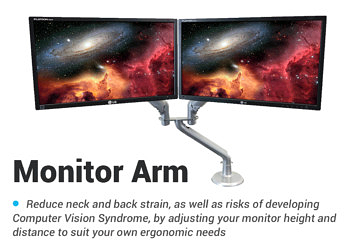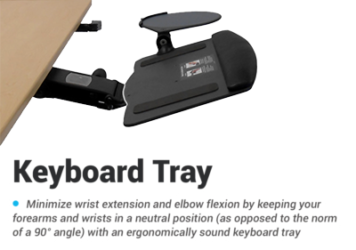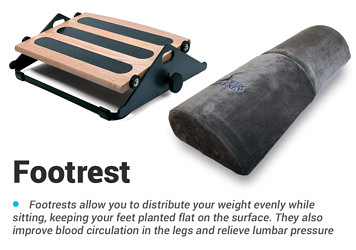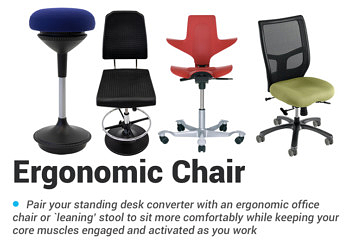Fully Remi Standing Desk Review
Like most reviews sites, our editorial staff and laboratory testing expenses are partially offset by earning small commissions (at no cost to you) when you purchase something through those links. Learn More

Overview
| Review Summary |
If you’re searching for the cheapest standing desk you could possibly buy while still getting decent support, the Remi is worth a look. But you have to accept its limitations in height adjustment range (only good for medium-height users), sizes (only three non-standard desktop sizes offered), finishes (only three desktop colors and two frame colors offered), and quality (really cheap particleboard desktop and flimsy TFL finishes). Still, it’s a better bet than other Chinese-made desks sold on Amazon that might cost $100-$200 less but be worthless in durability, with challenging customer support and returns. |
|---|---|
| MSRP / List Price | $479 |
| Street Price | Scan for available discount deals |
| Shipping |
Ship in three boxes |
| Warranty |
15 years on the frame and electromechanical components. 5 years on desktop |
| Lift Type |
2-segment, dual-stage electric lifting columns |
| Transit Speed |
1.1 inches per second |
| Sizes Available |
38″x27″, 46″x27″ and 58″x27″ |
| Colors Available |
Frame comes only in black and white. Desktop comes in only black, white and oak. |
| Adjustment Range |
Height range: 26.2″-45.8″ |
| Weight Capacity |
250 lbs |
| Typical Assembly Time |
Because power tools cannot be used, plan for at least 45 minutes with hand tools. |
| ANSI/BIFMA Certified |
No |
| NEAT™ Certified by Mayo Clinic |
No |
| Competition |
Compare to All Other Electric Standing Desks
|
| Where to buy |
Buy on Fully Buy on Amazon |
Rating
| Ease of Assembly | |
|---|---|
| Stability | |
| Reliability | |
| Customer Experience | |
| Quality and Aesthetics | |
| Ergonomics | |
| Innovation | |
| Value | |
| Suitability for Treadmill Desking | |
| Positives | If evaluating versus other sellers of even cheaper Chinese-made standing desks (especially on Amazon), the Remi is probably about as cheap as you want to go. While the quality, adjustment range, and selection of colors and sizes leaves a lot to be desired, (Fully offers the Jarvis in way more configurations) at least you can get domestic customer support from the Portland, OR company. A 15-year warranty backs that up. The desk ships out quickly from inventory because of the limited options. |
| Negatives | Because it uses only a 2-segment (dual-stage) lifting base, the Remi is suitable for medium-height individuals. It is unable to reach a usable range for shorter or taller individuals. The desktop is made of cheap particleboard with a cheap laminate that not only shows fingerprints and dirt badly, but is so brittle that Fully instructs you not to use a cordless screwdriver to assemble it. Thus you're looking at around 45 minutes of assembly with a Phillips screwdriver and a hex key. Only three odd desktop sizes are offered, in only three colors (and two base colors). |
Bottom Line
[Editors’ Note – April 21, 2023 – MillerKnoll, the $3B parent company of Fully.com, officially shut the company down on April 20th, 2023, after an 18-year run. Indeed, Fully’s phone lines and chat function have already been disabled, and the only way to reach customer service for product support is via email. We first reported this on March 8th after being notified by a number of Fully’s suppliers that the company was discontinuing operations.
Founded by ergonomics industry pioneer David Kahl in 2006, the company – which was originally known as ErgoDepot before a rebranding a few years ago – was acquired by Knoll. Knoll itself was shortly thereafter acquired by Herman Miller. This cataclysmic event is the latest in an ongoing set of challenges the industry has endured since the pandemic.
As a consequence of the company being wound down, we have taken down the scores for all of the Fully products we’ve reviewed to 0.5-star (including the Jarvis Standing Desk, Jarvis Standing L-Desk, Fully Jarvis Reclaimed Wood Standing Desk, Fully Jarvis Albright Standing Desk, Fully Jarvis Evolve Standing Desk, Fully Remi Standing Desk, Fully Jarvis Whiteboard Adjustable-Height Conference Table, Fully Jarvis Bamboo Adjustable-Height Conference Table, Fully Jarvis Tabletops For Standing Desks, Jarvis Monitor Riser, Jarvis Bamboo Desk Drawer, Fully Jarvis Single Monitor Arm, Fully Jarvis Dual Monitor Arm, Fully Jax Single-Display Monitor Arm, Fully Floatdeck Balance Board, Fully Sidekick Mobile File Cabinet, Fully Cable Management Kit and Fully Cable Management Tray). Fully has sadly been added to the Office Fitness Industry Dead Pool.
Ostensibly, Fully’s, “most popular products,” i.e. those that they still have a lot of inventory remaining, are being offered through the Herman Miller and Design Within Reach websites. We checked these listings and they are at full list price, unlikely to be purchased by any savvy shoppers. The nearest alternatives to Fully products are going to be found at iMovR (American-made) and UpLiftDesk (similar Chinese-made products). For more details on the company’s closure, see our article on Is Fully.com Out Of Business?]
Fully Reincarnates the Able Desk Co. ADC-SD1-101 as the New ‘Remi’ Budget Standing Desk
Fully is of course best known for its popular Jarvis Standing Desk, one of the leading Chinese-made standing desks on the market and one of the longest-selling models on the market. Fully competes head-to-head with UpLiftDesk, these days with their V2 Standard and V2-Commercial standing desks.
What the Jarvis and the UpLift V2 have in common is their commodity-quality Jiecang bases and Asian-sourced desktops, each vendor offering a gazillion flavors of their desk. Fully and UpLift are in a constant arms race to offer more sizes, finishes and other variations on the theme of a standing desk. If one can sell an accessory $5 cheaper than the other, they’ll do it—which one supposes is a good thing for consumers who are looking to pinch every possible penny.
Fully and UpLift together hold down the bulk of the mid-tier market, aiming primarily at millennials who are old enough to feel the pains of sitting disease, but are still on a tight budget. The boomers tend to go for the premium American-made desks with their higher quality components, greater selection of shapes and sizes, fancier desktop options and easier assembly.
And then there’s the exploding Gen-Z market. More tech-forward, e-commerce oriented, and generally less likely to spend a lot of money on quality, these consumers who were born after 1996 have been the mainstay of the third arch competitor in the trio with UpLift and Fully, Autonomous. The Autonomous SmartDesk 2 is probably the highest-volume, commodity-priced standing desk being sold today. It was apparently eating at the folks at Fully that there was even more downward price pressure if they wanted to pursue this growing, early-adopting market of the twenty-somethings.

In the summer of 2020, Fully stealthily launched a new brand, Able Desk Co., directly targeting Autonomous’ customer base with an equally cheap standing desk product and a messaging platform that made it sound like a start-up run by Gen-Z entrepreneurs, for Gen-Z consumers. We assume this surreptitious marketing ploy was intended to protect the golden goose, the Jarvis desk, from sales cannibalization.
As we covered in full detail at the time in our Able Desk Co. ADC-SD1-101 electric standing desk review, Fully felt it was important to look “genuine” for this audience. While mimicking Autonomous’ super-simplified, curated selection of only the most basic desk options and accessories (one file cabinet, one monitor arm, etc.) there was one inconvenient fact that popped up the same month Able Desk Co. was launched.
Portland, OR-based Fully, an earthy “B Corporation” that prided itself on its “woke” culture, had just been acquired by Knoll, a behemoth commercial office furniture company founded in 1938 with sales of $1.3 billion. Hardly a startup (and not that Fully was a startup anymore, either). Within very short order, Able Desk Co.’s massive launch campaign and business operation were halted. Though the site remains live, there is no traffic to it and all the products are “sold out.” Too much of a publicity risk for the new overlords, we have to guess.
The solution? Bring the Able Desk Co. product into the Fully.com fold and market it side-by-side with the Jarvis. Change the components a little here and there to disguise its identity, slap a new name on it—the ‘Remi’—and keep everything else the same, even the Portland, OR and Nottingham, MD rapid fulfillment warehouses.
How the Remi Compares to the Jarvis
To be clear, the Jarvis is no Cadillac. It is a commodity product made overseas that lacks the hallmarks of quality furniture, like ANSI/BIFMA certification. But it does come in a wide array of sizes, colors, and other configurable features. You can read our detailed lab tested review of the Jarvis to learn more, and compare it to all the other desks in the market in our comprehensive round-up of top standing desk reviews.

The Remi, on the other hand, is extremely constrained in its configurability. There are only three oddly-sized desktops to choose from, and they come in only three colors. But the biggest constraint is that, like the Able Desk Co. unit, it only ships with a dual-stage (2-segment) lifting base—meaning that its height adjustment range is only ideal for medium-statured individuals. Very short people will find it doesn’t go low enough for sitting, and very tall people will find it either comes up short or is very unstable at higher positions (because the lifting columns’ tubes have very little overlap at full extension). As opposed to the 25-inch “stroke” of a three-stage (3-segment) leg, the Remi has only a 20″ stroke. Unlike the Jarvis, there is no option for a full-range height adjusting base on the budget standup desk.
Let’s tick through the other key differences between the Remi and the Jarvis:
- Desktop quality: the Jarvis’ imported tops are not remotely state-of-the-art, but they at least manufactured with denser MDF cores so you can use a cordless screwdriver to drive screws into them without unintentionally ripping out the wood fibers. The particleboard used in the Remi tops is so brittle that Fully’s instructions advise against using power tools altogether. That means at least 45 minutes of hand driving screws and bolts with your Phillips screwdriver and a hex key. It’s as much fun as it sounds, but maybe if you’re an impoverished college kid you just don’t mind that sort of thing. To be fair, the Autonomous SmartDesk comes with 48 bolts and screws, while the Remi’s design is at least a bit more intelligent and merciful on the customer. The laminate itself is a very cheap ‘TFL’ (Thermally-Fused Laminate) that makes fingerprints very visible and is difficult to keep looking clean. (See our primer on Choosing the Right Desk Top to learn all about the different materials used in making tops for standing desks, e.g. 3D-laminate, solid wood, bamboo, reclaimed, etc.)
- Desktop size options: the Remi comes in three oddly-sized dimensions: 38″x27″, 46″x27″ and 58″x27″. Standard desk depth is 30-inches deep and “compact” desks are generally 24-inches deep, so this 27-inch depth bit unusual, though not a real problem for most users. The widths are also a little non-standard, either meant to distinguish the Remi from its cousin, or more likely based on maximizing yield from whatever the standard particleboard sheet sizes are that are sold in China. The Jarvis desktops, in contrast, are offered in 13 different shapes/sizes, and on more conventional increments for the US market.
- Desktop colors: the Remi comes in only black, white and oak. The Jarvis comes in 27.
- Frame colors: the Remi is offered in black or white. The Jarvis also comes in silver and metallic alloy.
- Height adjustment range: as mentioned above, the Remi’s range is quite limited. Where most standing desks sold these days reach at least 50″ (some as high as 56″) the Remi tops out at 46.75″ (with the 1″-thick top), and bottoms out at a lofty 27.25″ (as compared to the ANSI/BIFMA G1-2013 standards of 22″). In contrast, the Jarvis is offered with three base options. The dual stage has a similarly narrow height adjustment range of 30.1″ – 49.3″. And in three-stage, they offer a “low” for short users (23″ – 43.3″) and a “high” for taller users (25.6″ – 51.1″).
- Transit speed: the pokey Remi changes height at 1.1 inches per second versus the Jarvis’ 1.5 ips.
- Both desks come with dual motors, but the Remi’s rated lift capacity is 250 lbs versus the Jarvis’ brawnier 350 lbs. (See our primer on Do Weight Ratings on Electric Desks Really Matter?)
- Other minor differences include the spread between the legs of the desk and the quality of handset controllers.
Installation is a Bit of a Chore
As mentioned above, while the Remi is a simplified design that is in some ways even easier to assemble than the Jarvis, the particleboard desktop is too brittle to use power tools on. So be prepared to hand turn a Phillips screwdriver and a (supplied) hex key for the entire assembly. This is a first for our review team out of the many dozens of standing desks we’ve built over the years. The choice to go with particleboard as opposed to medium-density fiberboard (MDF) is indicative of cost-cutting decisions all around the desk. As the adage goes, “you get what you pay for, and you pay for what you get.”
The average user will need about 45 minutes to assemble the desk, which is actually faster than it takes to build a Jarvis desk without power tools.
Also, be sure to check out our review of Fully’s cable management kit to complete your workstation setup.
Stability
Because of its limited height adjustment range, it’s actually unfair to compare the Remi’s stability versus the Jarvis. A taller desk height will mean a higher center of gravity and more propensity to shake. The heavier frame and longer feet of the Jarvis effectively lower this center of gravity, but because of the odd desktop sizes on the Remi we can’t even do a true apples-to-apples comparison between the two. What we can say empirically is that taller users should be quite wary of the Remi’s height adjustment range limits, from a stability standpoint. If you want to learn more about recommended height ranges, be sure to read our primer on Tips for Taller Stand Up Desk Users.
The Takeaway
There are certainly cheaper, Chinese-made standing desks available on Amazon than the Remi. But if you want to make sure you get good support from a US-based support team, the Remi is about as cheap a desk as you’re going to want to risk buying, in our review staff’s expert opinion. While returns are easy on Amazon, disassembling and re-boxing a standing desk is a huge hassle.
See how the Remi compares to other standing desks under $800 for a good compare-and-contrast, outside of the natural comparison to the Jarvis. There are now American-made options close to this price point that will definitely deliver higher quality, better technology, plus more decor and size options than the Remi (e.g. iMovR’s Energize Compact in this size and budget range).
Many standing desks and converters come with grommets for some added convenience. Check out our article on grommet holes for everything you need to know about the different ways to use them to enhance your workstation, what to look for in your grommet holes, and where to find the desks with the best ones.






0 Comments
Leave a response >